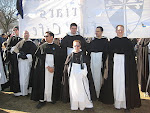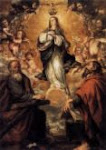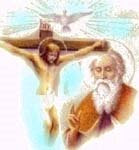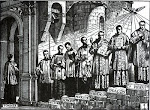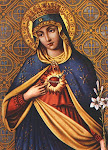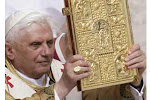This may interest some of you, the Nidus Choirs, Children and Adults singing O Holy Night. The song is available on iTunes. I am singing the solo, just out of interest. The blog will be returning shortly. We have had to take my mother, who has Alzheimers on a Christmas Trip to Germany, her homeland where she has not been for ten years and prior to that the time has been taken up by trips down to Wales to promote and sell the CD 'Christmas in Wales'. The Album is available via download from iTunes or you can buy it at
http://www.niduschildrenschoir.co.uk and it is all badly needed funds for their forthcoming competitions, which always cost a lot of money.
http://www.youtube.com/watch?feature=player_embedded&v=oeLa_8r2ZF4
Wednesday, December 28, 2011
Wednesday, November 2, 2011
Enchanting Shrine in Paradise, a holy and courageous Maiden, a Hare and -PENNANT MELANGELL
 Recently on travelling to a meeting at Holywell, I took a detour to Cwm Pennant, a landscape carved out of the last ice age and one of the truly breathtaking landscapes of North Wales-where there are plenty of them! Pennant means 'the top of the stream' and there is also a Holy well there, but higher up the mountain, where I did not have time to go. It is a remote place and the trees already brushed with autumn colours.In the sixth century this would have been a big and disparate parish, where mmost of the people lived and worked on the land. As we have learned, however, since then, the plague, movement to towns, reformation (which removed the running of the agriculture from monks and to friends of Henry VIII who subsequently turned people off the land and later enclosed it altogether, the people disappeared and the village became much smaller. Around the church are only a couple of houses and there are no inns.A stone preaching cross stood near what is now a car park and unfortunately there also seems to have been a cockpit there at one time. This was called 'Y Rheol' and the locals would gather there on a Sunday afternoon and watch small plays or Eisteddfods in the summer.
Recently on travelling to a meeting at Holywell, I took a detour to Cwm Pennant, a landscape carved out of the last ice age and one of the truly breathtaking landscapes of North Wales-where there are plenty of them! Pennant means 'the top of the stream' and there is also a Holy well there, but higher up the mountain, where I did not have time to go. It is a remote place and the trees already brushed with autumn colours.In the sixth century this would have been a big and disparate parish, where mmost of the people lived and worked on the land. As we have learned, however, since then, the plague, movement to towns, reformation (which removed the running of the agriculture from monks and to friends of Henry VIII who subsequently turned people off the land and later enclosed it altogether, the people disappeared and the village became much smaller. Around the church are only a couple of houses and there are no inns.A stone preaching cross stood near what is now a car park and unfortunately there also seems to have been a cockpit there at one time. This was called 'Y Rheol' and the locals would gather there on a Sunday afternoon and watch small plays or Eisteddfods in the summer.The first thing you notice about the church is the circular churchyard, with its familar form of desert island monastic outlay. Then there are the sacred circle of yews all around the church. If you remember from previous blog posts, the early monastics were in communion with Rome,and followed the lead of the desert fathers. The boundaries marking the delineation of God and Heaven, where people were buried. At the heart of the enclosure was the Church, and at the heart of the Church in the sanctuary, the sanctuary lamp rreminded people of the live throbbing heart of Christ in the Eucharist, which stood at the heart of every church for the first 1,530 years approximately since the earthly death of Our Lord. This was indeed a light brought to the gentiles. The language of the liturgia of the Welsh church was Latin and the monks would chant their offices, often to the sound of the harp. these ecclesiastical enclosures often schooled boys and chieftains of the secular llans often nearby. Yet the village of a religious llan was a small community, where lay people also lived to sserve the monastic community. Some priests were married, and others were not. Bishops could not be.
When Gregory the Great sent his priests on Missions to Britain, he told them not to destroy ancient sites of worship, but to Christianise them and there seems to be some evidence that St Melangell's church(the original mud and wattle church) was built over the site of a Bronze age Barrow, or funeral chamber.The five sacred yew trees around the church are at least 2,000 years old! Around the lych gate (Lych=Saxon-German-Leiche -body or Welsh Llwybr y Corph) are two standing stones brought from early days and fragments of the original shrine of St Melangell are built into the lych gate itself, when the shrine was restored.the preaching cross has been removed from the car park area to the churchyard . Very high status people seem to have been buried here Guto'r Glyn writes of Einion ap Gruffud of Llechwedd Ystrad, a great Welsh poet, who had his Requiem Mass celebrated here and was then buried here, after a life coming to the church on pilgrimage.
A Phennant i gorff Einiawn
Oedd wyddfa Iwys, deddfol iawn
It was Pennant for Einion's body,was a fitting resting place,and very holy.
Saints Festivals and Vigils
Before the Reformation Holy days were celebrated in the church and churchyard. Rustic games prevailed. One such rite was on the vigil (night before the saint's day) young people would do a circular dance around the churchyard and then go into church and confess their sins! But games were also played in celebration of the saints life and witness to the faith. The Communion of Saints, those on earth and those , unknown and known in heaven was a strong part of the faith and the church on earth and in heaven not divided by death.So all rejoiced and celebrated. Masses too on a Sunday began in the Churchyard. It was the day of the Lord's Resurrection and hymns on feast days began outside and there were also prayers prior to going in for the Mass in a joyous procession. Henry VIII ended all this.
Eighteenth Century
By the eighteenth century, the Church was in poor repair and we have to thank Edward Madocks and David Thomas for this restoration. Other people in the parish contributed individual repairs to proches, gates and windows. While much was restored in a more modern style the Romanesque 12 century arches can still be seen inside. It seems the church was similar in shape to the original. The restorers had replaced the small 18th century 'cell y bedd' end of the church, with an apse, in a similar shape to the twelfth century apse.This blends perfectly with the mediaeval building which has kept its original shape and is quite a large church too for this part of Wales. What is beautiful is that the Rood loft has not disappeared. The carvings have lost their colour and their gold and Our Lady and St John have disappeared, along with the painting of the Doom, but the plain oak screen survives with a more modern crucifix above, not displaying the wounds.This seems to be a repair of the original rood screen which will have been torn down by Elizabeths bailiffs, but most old churches are completely lacking it.This screen was dismantled and returned to its original position with a new loft in panelled oak. The figure of Our Lord is in Bronze and sculpted by Kathleen Fuller. The tracery is carved from a solid piece of oak with cusping and foliation features and with panels of the orignal brought back from the back of the church, tracery heads show wgere thhe eleven apostles would have been shown, and there are decorations of oak leaves, acorns, vine leaves, roses, a hand (maybe a symbol from the 5 Wounds devotion) a mythical bird and a 'green man'. The rarest thing is the legend of St Melangell after whome the church was named.
The Vita of St Melangell
It was one of the biggest teaching of the early Catholic church, that women had the right to consecrate themselves to the Lord, and had the right not to be forcibly married. Forced marriages were crimes and some holy women, including St Tekla (st Paul's diciple) were tortured for not capitulating to her fammily's demands. St Winifred too paid the price for her virtue, and St Melangell was no exception in displaying an almost foolhardy courage. In the Vita (Life) of St Melangell (Called Sancta Monacella in Latin) The local bards in Wales took great care to commit such stories to memory and pass them on to their sons. Druidism had gone underground, and yet their ability to remember the ancient accounts meant, that as those powerful Welsh nationalists, the Cistercians arrived and the learned Benedictines, they were able to write them down, where they would be read by posterity. We have a great deal to thank them for. Before being sceptical of their truth, we ought to remember that a Church and llan would not be named after a female saint unless she was very special, and very holy.
Waldo Williams 1904-1971
In complete harmony with the teaching of the Communion of Saints, peace and reconciliation, the great Welsh poet took this as one of his major themes. He was a great ecumanist , brought up as a Baptist, became a Quaker but under the influence of the Russian Orthodox Philosopher Nicolas Berdyaev. One of his finest poems is addressed to the Catholic Martyrs of Wales at the Reformation, whose story had been forgotten , but whom he now celebrates in 'After the Silent Centuries'. He wrote about St Tyssilio of Meifod-a peacemaker, a warrior who renounced violence, like St Derfel. He also writes of Brynach an Irish priest who served at Brychan's court in Talgarth and later at Nevern. Of Brynach we are told, he talked with angels on the hill behind his home.A.M Alchin writes in his excellent account of the pilgrimage site :It is not difficult to think of St melangell talking with angels in this beautiful valley'. In his poem in honour of St Brynach Waldo addresses God as the 'Lord and Shepherd of All ages' who gathers together past and present in one, This is a very beautiful poem, and as we have seen in Llanthony in South Wales, even in Celtic times , where nature all around is living, the veil between heaven and earth is very thin, and was torn down by Christ.
Awakener of the grey mornings in our land
Dawn is not only clear and shining
You have given us on the moorland of time
The light of an unfading hour.
You have reawakened our spirits
The Old Kinship of Earth and Heaven.
In the same poem, Alchin writes,' Waldo sees the saints of Wales standing as guardians around the ;and, by their example giving us new courage, and strengthening us when we feel fearful or sad.He evokes the Holy Wells of Wales as sources of living strength for us now....
Brynach, Irishman, pray for us
May your prayers flow together with ours'.
Waldo wrote of the world in faith and experience, to which the saints belong, the early Celtic experience merging with today's future and even earlier saints where the centuries are distilled into one of the angels and archangels and all the saints company of earth and heaven, known and unknown
St Melangell's Vita
The Historia Diviae Monacellae tells how in the year 604 AD Prince Brochwell Ysgrithog was hunting in Pennant when his dogs chased a hare into a large thicket of brambles. Inside this thicket was a beautiful and holy woman who was at her prayers in her own retreat. The hare went for safety under her robe and cloak. After glaring at her, the dogs fled howling, unable to enter. The Prince discovered she was Melangell, of Moncella, an Irish King's daughter who had come to Wales fifteen years before to escape a forced marriage. She was leading a hermit's life of rest and contemplation. Brochwel was so moved by her quiet courage, reverence and piety, he gave her the valley as her place of sanctuary. Acclaimed a saint by local people after her death, St Melangell had founded a female monastic house here and she lived here for many years in friendship with the animals.Another detail was added from local sources as late as the eighteenth century, that Thomas Pennant , a visitor was told that the prince's huntsman had tried to sound the horn to make his hounds go into the thicket, but the horn stuck to his lips! Whether this was a case of later embroideryh we will never know.The figures of the foliage in the frieze on the rood screen tall the same story.
The Shrine of St Melangell
 Unusually, the shrine in the chancel dominates the church. It was constructed ca 1160-70 AD to hold the relics (bones and possessions) of the saint. The saint was revered and honoured here for centuries and when Henry VIII robbed such shrines, £2.14.6d were taken by his men in 1535, being the offerings of pilgrims for the upkeep of the shrine.In John Hainsworth's excellent guide to the church, he recalls in recent memory a building called 'The Herberage' where people rested on their pilgrimage.1561 Elkizabeth I gave the order to destroy it, and pieces of it were built into various bits of the wall and buildings, but were identified in 1894 and put together again and brought back into the church. They were rescued in 1958 and pieced together and reerected in the building which had replaced the apse, During 1989, the shrine was rebuilt in the chancel .Traces of colour have been found and the restorer Robert Heaton , used concrete to show the new work,It is made of yellow sandstone and has Celtic and Romanesque elements. There is a votive stand-.The effect must have been rich and emotional. This reconsituted shrine is unique in Britain. It is thought that originally there was a lower level into which the shrine was built.
Unusually, the shrine in the chancel dominates the church. It was constructed ca 1160-70 AD to hold the relics (bones and possessions) of the saint. The saint was revered and honoured here for centuries and when Henry VIII robbed such shrines, £2.14.6d were taken by his men in 1535, being the offerings of pilgrims for the upkeep of the shrine.In John Hainsworth's excellent guide to the church, he recalls in recent memory a building called 'The Herberage' where people rested on their pilgrimage.1561 Elkizabeth I gave the order to destroy it, and pieces of it were built into various bits of the wall and buildings, but were identified in 1894 and put together again and brought back into the church. They were rescued in 1958 and pieced together and reerected in the building which had replaced the apse, During 1989, the shrine was rebuilt in the chancel .Traces of colour have been found and the restorer Robert Heaton , used concrete to show the new work,It is made of yellow sandstone and has Celtic and Romanesque elements. There is a votive stand-.The effect must have been rich and emotional. This reconsituted shrine is unique in Britain. It is thought that originally there was a lower level into which the shrine was built.One more unique element-Survival of Relics?
During the excavarions of 1958, the skeletal remains of a 5 feet woman and these bones were kept in the Anglican Rectory for some years. It is likely the Elizabethans would have though it sacrilege to destroy her remains and may have secretly and reverently buried her. Further fragments were found in 1989. There is always going to be an element of risk as to whether thesse were the bones of St Melangell, however, had they identified such remains, they would have almost certainly been destroyed in the hateful time of iconoclasm, both then and under Cromwell.
The Powis Family
Were a local and loyal Catholic family of means, who are said to have taken some of the bones for safety to St Omer in Northern France, where many of the priests of the 'English' mission were trained. The bones of a great saint are considered a powerful prayer aid, linking the saint's intercession with your own. These priests returned as single men to minister the original Christian faith to their flock and were often killed if found and sometimes hung drawn and quartered. There is interestingly a cult of St Melangell at St Omer .It seems the Powis Family may have brought it, to focus the minds of the priests returning to Wales to venerate and ask St
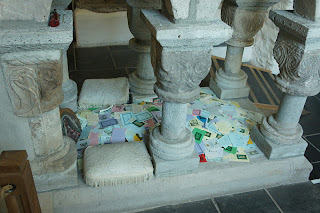 |
| Requests for the saint's intercession |
St Melangell's is now part of the Anglican Church in Wales structure and it appoints a Guardian of the Shrine and a Vicar in Charge of the shrine. Pilgrimages are held here and many people come to visit.
‘The Book of Saints’ Compiled by the Benedictine Monks of St. Augustine’s Abbey, Ramsgate (sixth edition 1989/94) ISBN 0304343579 notes that her feast is May 27th and that she died c590. Others date her death to c607, c641 or even early 8th Century. Directions: Satnav:SY10 OHQ near OSWESTRY in Shropshire. Get off the M5/6 at Birmingham on M54 to Shrewsbury and then follow signs to Oswestry.
Monday, October 10, 2011
Languerntuiauc or Gwernesney in the leafy alder grove
 Gwernesney Lan-guern-tuiauc is the name suggested for Gwernesney in the 12th Century Book of Llandaff. The dedication is unknown, although no doubt monks from the local 6th century monasteries (there were several locally, from Michaelston le Fedw in Glamorgan, from a very early time, to the work of St Brynach at the court of Brychan Brycheiniog in Talgarth (Garth Madrun) and of course St Tathw's monastery at Caerwent, where St Tathw (Meuthi later the hermit who taught St Cadoc) who also sent out monks as well as the prolific St Dyfrig, from his
Gwernesney Lan-guern-tuiauc is the name suggested for Gwernesney in the 12th Century Book of Llandaff. The dedication is unknown, although no doubt monks from the local 6th century monasteries (there were several locally, from Michaelston le Fedw in Glamorgan, from a very early time, to the work of St Brynach at the court of Brychan Brycheiniog in Talgarth (Garth Madrun) and of course St Tathw's monastery at Caerwent, where St Tathw (Meuthi later the hermit who taught St Cadoc) who also sent out monks as well as the prolific St Dyfrig, from his There were also the famed monastery of Illtyd, at
based at Llantwit Major and St Cadoc's at
Llan carfan, both in earlier M & M posts.
A family member of Brychan's house is most likely,but looking at Tiuauc and( Tydiwg) we do have a Gwent saint, supposedly a brother of St Carannog of Llangrannog, St Tysoi of nearby Llansoy. He was meant to be the son of Ceredig an Cunedda . This is mentioned in Progenies Keredic at the end of the Cognatio de Brychan in the Cotton MS Vesp A xiv. Henlann (old llan ) Tituic is the place named at Dixton on the Wye. Nevertheless, this is not difinitive, just based on a possibility.
The fact was that at this time of the early foundations of these foundations of 'deserts' shielding people from the outside world, and making a heavenly circle was part of the process of emulating the desert monks. After all this was post Roman Wales, under attack by Angles, Saxons, Irish and other Welsh tribes, and they were well aware of the world wide church and used Latin in their Masses. In fact such large numbers of people fleeing from the English pagans, made it imperative to encourage large numbers of celibate monks, as the land was unable to sustain such large numbers otherwise.
Llans were devised under a local founder who had received his training at one of the great learned centres. There was also one at Llanfeuno. Some local saint, or holy priest, trained at a centre obviously set up his Llan here in the alders. They would usually make a circle, build a church and burial area, but would be granted land from the local chieftain. It would usually be near a well or a stream, which would serve for Baptisms and holy water, blessed by the saint-founder. The church would be the centre of the llan's life and inside the church, the Sanctuary, the beating heart, in which the Body and Blood, Soul and Divinity of the Lord would be revered and adored on the altar, surrounded by light. Not all Llans were religious, some were those settlements built by
chieftains, but ecclesiastical llans were useful. They provided schools, farmed land,and looked after the sick. When the Normans came, and the churches came into the Diocese of Llandaff, Morgan Hen, the chieftain gave this little church to Gwrgan, Bishop of Llandaff. What are now two parishes sustained the church, and used to be called the 'Slough'.(Yelwch) and these used to be separate lands.
P Edward Gostwyck mentions Gwernesney as part of the
lands of Usk Priory. It would have been served by one of its priests, the tithes given to the nuns there for the upkeep of the priory. In fact it was a larger version of what happened before A holy life was truly revered and de Clare clearly had an eye to his eternal Salvation when he founded the place .Dame Elen Williams, a local lady was the last Abbess, and when priests were outlawed, after Henry founded his new church, Griffith ap Howell was the last Catholic priest in 1535, bringing to an end the Catholic occupancy which had been since the sixth century. In 1560 there was a 'parson' called Walter David and 1621 we learn even the parson Edward Williams was deprived of the church for being drunk and swearing and reading the 'Book of Common Prayer' !He lived to be restored, but died in 1664. All in all, it was a colourful period.
The Scudamore Family were from the parish, and in 1697 John Scudamore was responsible for the arrest and tragic death of the Beloved Father of the Poor, Tad y Tlodion, St David Lewis.
When the church closed as a Catholic church,the surrounding lands were being farmed by a local tenant farmer,Philip Williams, known as 'Gwyn' who was inhabiting 'Gwern Stockhouse' next to the church and also rented another group of property from the nuns and clearly Richard Ryche and others who signed the supression faces.
The 'meadows' were bringing in 7 shillings a year-which was a good rent. The Church was clearly an unophisticated and simple, Living so closely to the land, a simple priest priest would hav survived.
An interesting Church with a beautiful set of Stations of the Cross.
Tuesday, September 20, 2011
The Miracle of Mamhilad.
The Life of St Illtud, now in the British Museum in the Cott Manuscript mentions he was Breton and a great nephew of the holy Saint Germanus of Auxerre. (Vespasiab A XIV) \He was known to be very warlike and physical and heard a lot about Britain from his British mother. He resolved to go there and to join a war band, possibly of his kinsman Athrwys,He was given an excellent education in all seven sciences , was baptised and catechised and studied elementary science , but then he decided to go to war and break of his studies, appearing in Britain at the court of the chieftain Paulinus Paelin, and his war leader, Arthrwys.They treated him well, as he was a good companion , learned and a good governor. He was one of the most intelligent of all the solders and became a leader in King Paulinus' household.
One day King Paulinus took the royal household to hunt over the land belonging to St Cadoc, and he was rude enough to send a message to the Holy Abbot Cadoc, that if he did not provide them all with dinner, he would take it by force. Cadoc was surprised at the tone of the request, but nevertheless sent them all dinner. The household sat down to dine, but because of the sacrilege of their request, they were all taken ill and left but Illtyd escaped . He was far away with a hawk and knew nothing of it. Seeing the effect of the Kings disappearing household, Illtyd went to Cadoc to ask what had happened. St Cadoc told him to take of his secular dress and but on a clerical habit, and required that he serve the Creator God all his life so he could do penance for the misdeeds of his household, do God would deal leniently with him at the Judgement. Illtyd returned to King Paulinus and withdrew himself from secular services after that. He left the area and came to the River Daw in Glamorgan and left his wife after an angel commanded him to serve the King of kings, and he realised that he had to devote himself to God and gave up his wife in atonement for all those he had killed as a soldier.
He retired to the Hodnant valley. which was either at Llantwit on the sSevern or at Llanthony, named after the Hodnant in the Welsh.He became a great saint, and ended his days in Llantwit Major (Llanilltyd Fawr) This is a very interesting Church to visit, showing much early history.There is a project afoot to restore the Galilee Chapel from a ruin, to which it was reduced under Henry VIII. The land St Cadoc owned and had founded was based on his teacher , Tatheus (Meuthi-the Hermit) as Tre-feuthin-the Homestead of the Hermit.
Some time after the death of St Cadoc, he was returned to his principal monastery of Llancarfan, where his relics were revered and honoured by his sorrowing brothers.There were thirty six canons at llancarfan, like Llantwit Major a huge monastery and there were vast numbers of gardeners and also other lay brothers and sisters in his llan.
Llifris writes:
No one can relate the miracles performed by St Cadoc
It is because he is not here with his mode of speaking
Christ the Creator of the World will grant pardon
To him who write a Life with faults, named Llifris.
A powerful Saxon leader came from England, with a large body of men, intent on despoiling and pillaging in Wales . He arrived at the coast in a ship, but the clergy of Llancarfan, fled the monastery taking their treasure with them and fled from there with the reliquary of the Holy Man, and other relics , which they prayed would protect them from their pursuers and they hid themselves in a llan of St Illtyd, which readily gave protection and shelter to the followers of this holy saint. The name of the llan was St Illtyd's , in a place which became known as Mamhilad trans:The Place where the Coffin was Brought)When they had been there a short time, the Saxon raiders were also joined by Danes who had heard there were rich pickings in store.
When they saw the coffin with the Holy Saint in it at Mamhilad, they tried to lift it, first four men, then in the end many many men tried to lift it, but it would not budge, They were not able to move it at all. Then they became angry and one, more enraged than all the others, ran forward quickly and struck the coffin hard, and on being struck, it produced a loud bellowing noise like a bull, and greatly frightened the whol.e army and there was a great earthquake at Mam hilad. The coffin was deserted, the enraged soldier, induced by greediness cut of a gold pinnacle from the coffin of the Holy Man, which fell into his lap and immediately he felt as if fire was buirning his chest. Stupified and excited by the pain of the heat, he put the pinnacle back, and it firmy affixed to where it had been cut off, as if it had been soldered on safely. When he had done this the unhappy violator of the coffin died in front of the coffin, seemingly melting into the ground and the foreigners fled, and cceased to worry them.
The brothers decided to take Cadoc over the mountain to his old llan at Tre-Feuthin and here ie was safe from the maraudoing Saxons.Cadoc was lad to rest with great honour at the early site. Later many people were trained at his monastary.
St Illtyd and St David, appear in Stained glass in this ancient church.
The sanctuary area as seen from the nave. Originally the screen would have been erected over the arch, the rood (Crucifix would have been up there, with Blessed Mary and St John, and parishioners would have said their confessions before Easter under the rood.
 St Cadoc, ddoth. Born at Newport and trained and educated at Caerwent with St Tatheus, who retired to a hermits life at Tre-feuthin. St Cadoc was the son of King Gwynlliw and Queen Gwladys, daughter of Brychan Brycheiniog. Both his parents took Holy Orders in Old Age. Cadoc's white martyrdom took him all over Britain, even to Scotland and to Southern England and South Wales,and he even went to France during the plague known as the Yellow Fever. St Cadoc is well known in France, where an island is named after him.
St Cadoc, ddoth. Born at Newport and trained and educated at Caerwent with St Tatheus, who retired to a hermits life at Tre-feuthin. St Cadoc was the son of King Gwynlliw and Queen Gwladys, daughter of Brychan Brycheiniog. Both his parents took Holy Orders in Old Age. Cadoc's white martyrdom took him all over Britain, even to Scotland and to Southern England and South Wales,and he even went to France during the plague known as the Yellow Fever. St Cadoc is well known in France, where an island is named after him.
One day King Paulinus took the royal household to hunt over the land belonging to St Cadoc, and he was rude enough to send a message to the Holy Abbot Cadoc, that if he did not provide them all with dinner, he would take it by force. Cadoc was surprised at the tone of the request, but nevertheless sent them all dinner. The household sat down to dine, but because of the sacrilege of their request, they were all taken ill and left but Illtyd escaped . He was far away with a hawk and knew nothing of it. Seeing the effect of the Kings disappearing household, Illtyd went to Cadoc to ask what had happened. St Cadoc told him to take of his secular dress and but on a clerical habit, and required that he serve the Creator God all his life so he could do penance for the misdeeds of his household, do God would deal leniently with him at the Judgement. Illtyd returned to King Paulinus and withdrew himself from secular services after that. He left the area and came to the River Daw in Glamorgan and left his wife after an angel commanded him to serve the King of kings, and he realised that he had to devote himself to God and gave up his wife in atonement for all those he had killed as a soldier.
He retired to the Hodnant valley. which was either at Llantwit on the sSevern or at Llanthony, named after the Hodnant in the Welsh.He became a great saint, and ended his days in Llantwit Major (Llanilltyd Fawr) This is a very interesting Church to visit, showing much early history.There is a project afoot to restore the Galilee Chapel from a ruin, to which it was reduced under Henry VIII. The land St Cadoc owned and had founded was based on his teacher , Tatheus (Meuthi-the Hermit) as Tre-feuthin-the Homestead of the Hermit.
Some time after the death of St Cadoc, he was returned to his principal monastery of Llancarfan, where his relics were revered and honoured by his sorrowing brothers.There were thirty six canons at llancarfan, like Llantwit Major a huge monastery and there were vast numbers of gardeners and also other lay brothers and sisters in his llan.
Llifris writes:
No one can relate the miracles performed by St Cadoc
It is because he is not here with his mode of speaking
Christ the Creator of the World will grant pardon
To him who write a Life with faults, named Llifris.
A powerful Saxon leader came from England, with a large body of men, intent on despoiling and pillaging in Wales . He arrived at the coast in a ship, but the clergy of Llancarfan, fled the monastery taking their treasure with them and fled from there with the reliquary of the Holy Man, and other relics , which they prayed would protect them from their pursuers and they hid themselves in a llan of St Illtyd, which readily gave protection and shelter to the followers of this holy saint. The name of the llan was St Illtyd's , in a place which became known as Mamhilad trans:The Place where the Coffin was Brought)When they had been there a short time, the Saxon raiders were also joined by Danes who had heard there were rich pickings in store.
When they saw the coffin with the Holy Saint in it at Mamhilad, they tried to lift it, first four men, then in the end many many men tried to lift it, but it would not budge, They were not able to move it at all. Then they became angry and one, more enraged than all the others, ran forward quickly and struck the coffin hard, and on being struck, it produced a loud bellowing noise like a bull, and greatly frightened the whol.e army and there was a great earthquake at Mam hilad. The coffin was deserted, the enraged soldier, induced by greediness cut of a gold pinnacle from the coffin of the Holy Man, which fell into his lap and immediately he felt as if fire was buirning his chest. Stupified and excited by the pain of the heat, he put the pinnacle back, and it firmy affixed to where it had been cut off, as if it had been soldered on safely. When he had done this the unhappy violator of the coffin died in front of the coffin, seemingly melting into the ground and the foreigners fled, and cceased to worry them.
The brothers decided to take Cadoc over the mountain to his old llan at Tre-Feuthin and here ie was safe from the maraudoing Saxons.Cadoc was lad to rest with great honour at the early site. Later many people were trained at his monastary.
St Illtyd and St David, appear in Stained glass in this ancient church.
The sanctuary area as seen from the nave. Originally the screen would have been erected over the arch, the rood (Crucifix would have been up there, with Blessed Mary and St John, and parishioners would have said their confessions before Easter under the rood.
The nave and Sanctuary at St Cadocs
The Ancient and beautiful rood loft, which was saved from Cromwell and the Tudor wreckers. Such screens were very expensive and usually donated by a wealthy parishioner. The screen has been put at the rear of the church
 St Cadoc, ddoth. Born at Newport and trained and educated at Caerwent with St Tatheus, who retired to a hermits life at Tre-feuthin. St Cadoc was the son of King Gwynlliw and Queen Gwladys, daughter of Brychan Brycheiniog. Both his parents took Holy Orders in Old Age. Cadoc's white martyrdom took him all over Britain, even to Scotland and to Southern England and South Wales,and he even went to France during the plague known as the Yellow Fever. St Cadoc is well known in France, where an island is named after him.
St Cadoc, ddoth. Born at Newport and trained and educated at Caerwent with St Tatheus, who retired to a hermits life at Tre-feuthin. St Cadoc was the son of King Gwynlliw and Queen Gwladys, daughter of Brychan Brycheiniog. Both his parents took Holy Orders in Old Age. Cadoc's white martyrdom took him all over Britain, even to Scotland and to Southern England and South Wales,and he even went to France during the plague known as the Yellow Fever. St Cadoc is well known in France, where an island is named after him.
Labels:
King Meirchion Illtyd,
Mamhilad,
St Cadoc
Thursday, August 25, 2011
Return from Germany and Saint Mary at Bethen in Cloppenburg
http://www.stmarien-bethen.de/
If you would like to know more and use google translator
I spent the last ten days in Oldenburg, where I was born. My Mum was German and my father from South Wales. Notwithstanding my Mother being a German Lutheran, not in communion with the Catholic faith, I decided I would attend the church of Pilgrims in Cloppenburg, South of Oldenburg, which I found was buzzing with excitement because of the imminent visit of the Holy Father. At a time of such large scale apostasy in Europe, the visit of the successor of Peter was a sign of hope. The weather was terrible, but apparently on the major days of remembrance for Mary, many people walk from Cloppenburg to this site-also from Oldenburg I understand to thank her for co-operating with God to give our Saviour a human body. I was moved to wonder, whether Jesus looked like her.
Last Sunday was the Feast of the Assumption. Along with Enoch and Elijah, from the very earliest years of the Church was the tradition, that Mary, the Woman of Revelations 12 was taken body and soul into heaven to be with her Son, who loved her as we all love our Mothers. This Mother, who could have been stoned to death for agreeing to bear the Saviour whilst unmarried was the most Perfect Christian, giving God a body, then giving his Mother to be the Mother and Ikon of all His People. The Assumption was only made an official Dogma, after people started chipping away at this age old dogma.
On this day , there was a pilgrimage with all the people bringing herbs and wild flowers to the shrine. In German the words 'Heilkraut' are healing herbs, which the ladies brought there to give to Mary, to thank her for her role in giving birth to our Lord 'Behold the Handmaid of the Lord, Be it done to me according to Thy Word'. The priest told us, that Mary reminds us that we are flesh and blood humans, just as she was, and yet God can wreak enormous Love and Sacrifice from us too, and a call to Divinity, when we have Faith in and trust the Saviour and keep his Commandments in our struggle to be Holy and Members of His Body on Earth. It was also mentioned that Our Saviour loved us so much that he took on the frailty of our mortal bodies, nut he overcame it all to conquer death.
The Ark of the Covenant contained
The Torah-the Word of God
The Rod of Aaron-the symbol of the High Priest of God
The Manna -the physical food given to the Israelites in Canaan, when they were starving on the Way to the Promised Land.
Mary, the Ark of the New Covenant contained in our Blessed Saviour:
Jesus, the Word of God, in tradition of the early Apostles (St John tells us not all was written down about Jesus)
Jesus, the High Priest, King of all us Christians, called to be priests and evangelists of His Word.
Jesus, the Eucharist , who feeds us with his Body and Blood, when we are starving in the Wilderness of a world , living among some sinful and wicked people, who have turned away from Him and His teaching, and have renounced him and been led away from Truth.
Little Holy Mary, pray for us Sinners, that we may be made worthy of the Promises of Christ.Little, holy Mary may we all appreciate your tremendous act of Faith, and give us courage to carry on in our day to day lives, getting closer and closer to Jesus.
Podcast from St Maria Bethen Shortly.
If you would like to know more and use google translator
I spent the last ten days in Oldenburg, where I was born. My Mum was German and my father from South Wales. Notwithstanding my Mother being a German Lutheran, not in communion with the Catholic faith, I decided I would attend the church of Pilgrims in Cloppenburg, South of Oldenburg, which I found was buzzing with excitement because of the imminent visit of the Holy Father. At a time of such large scale apostasy in Europe, the visit of the successor of Peter was a sign of hope. The weather was terrible, but apparently on the major days of remembrance for Mary, many people walk from Cloppenburg to this site-also from Oldenburg I understand to thank her for co-operating with God to give our Saviour a human body. I was moved to wonder, whether Jesus looked like her.
Last Sunday was the Feast of the Assumption. Along with Enoch and Elijah, from the very earliest years of the Church was the tradition, that Mary, the Woman of Revelations 12 was taken body and soul into heaven to be with her Son, who loved her as we all love our Mothers. This Mother, who could have been stoned to death for agreeing to bear the Saviour whilst unmarried was the most Perfect Christian, giving God a body, then giving his Mother to be the Mother and Ikon of all His People. The Assumption was only made an official Dogma, after people started chipping away at this age old dogma.
On this day , there was a pilgrimage with all the people bringing herbs and wild flowers to the shrine. In German the words 'Heilkraut' are healing herbs, which the ladies brought there to give to Mary, to thank her for her role in giving birth to our Lord 'Behold the Handmaid of the Lord, Be it done to me according to Thy Word'. The priest told us, that Mary reminds us that we are flesh and blood humans, just as she was, and yet God can wreak enormous Love and Sacrifice from us too, and a call to Divinity, when we have Faith in and trust the Saviour and keep his Commandments in our struggle to be Holy and Members of His Body on Earth. It was also mentioned that Our Saviour loved us so much that he took on the frailty of our mortal bodies, nut he overcame it all to conquer death.
The Ark of the Covenant contained
The Torah-the Word of God
The Rod of Aaron-the symbol of the High Priest of God
The Manna -the physical food given to the Israelites in Canaan, when they were starving on the Way to the Promised Land.
Mary, the Ark of the New Covenant contained in our Blessed Saviour:
Jesus, the Word of God, in tradition of the early Apostles (St John tells us not all was written down about Jesus)
Jesus, the High Priest, King of all us Christians, called to be priests and evangelists of His Word.
Jesus, the Eucharist , who feeds us with his Body and Blood, when we are starving in the Wilderness of a world , living among some sinful and wicked people, who have turned away from Him and His teaching, and have renounced him and been led away from Truth.
Little Holy Mary, pray for us Sinners, that we may be made worthy of the Promises of Christ.Little, holy Mary may we all appreciate your tremendous act of Faith, and give us courage to carry on in our day to day lives, getting closer and closer to Jesus.
Podcast from St Maria Bethen Shortly.
Monday, August 8, 2011
MARY ON HOLIDAY--THE HIDDEN CISTERCIAN GEM OF NETLEY ABBEY
As a guest on a yachting holiday to Cowes, in the Isle of Wight, we stayed at a village called Netley Abbey. Actually finding it was tricky but we managed with the help of a satnav! The whole village once belonged to the Abbey and indeed Netley Abbey is the most complete, surviving Cistercian monastic ruin in England, and an unexpected hidden gem in the middle of a small village and estate.The ruins show the remains of 800 years of change, from a Cistercian house to a mansion for one of Henry VIII's henchmen and finally it was sold for masonry and became a Romantic ruin. The Cistercians must have enjoyed a wonderful life of prayer in this setting overlooking the Solent!Now there is a hedge and it is protected by English Heritage.
The Abbey was founded by monks from nearby Beaulieu Abbey by Peter des Roches the powerful Bishop of Winchester in 1238 and there were 15 monks, but 30 lay brothers and other employees, officials and labourers.
In the sad years, when the king wished to marry his mistress, the Abbey was closed and taken by the king and sold at a knockdown price to his supporter in this venture Sir William Paulet. Who built a Tudor Courtyard palace on the site, using the buildings that were there in 1536. By the 18th century, repairs became too costly and by 1704 the house was abandoned to provide stone for building but painters, poets and writers arrived there, taking inspiration from the spiritual nature of the building.The Abbey was only saved, when work demolishing the Abbey was stopped, when a worker was killed.
Horace Walpole, Jane Austen and many others visited the Abbey, inspired by its grandeur-even as a shell. Northanger Abbey may have been inspired here, so close to the coast.It was a popular place for people from the nearby area to come and have ginger beer and a party, but by the twentieth century, antiquarian interest stopped such things and admiration for the gothic masonry of the abbey, made them remove all the vestiges of the Tudor mansion, which had decayed and restored it. It is now cared for by English Heritage, and a hidden gem in the rural landscape.All was still there, the book room, the kitchen, the enormous church.
For its short tenure by Sir William Paulet,from 1536 to 1704 , the death of the demolition worker and the giving up of the house for masonry, you have to ask whether the theft of the monastery was worth it, even for the vanity of one of the people charged with closing these houses of prayer-which often incorporated hospitals.... A sad chapter in our history.
If you are around Southampton, visit Netley, and see the hidden gem!
The Abbey was founded by monks from nearby Beaulieu Abbey by Peter des Roches the powerful Bishop of Winchester in 1238 and there were 15 monks, but 30 lay brothers and other employees, officials and labourers.
In the sad years, when the king wished to marry his mistress, the Abbey was closed and taken by the king and sold at a knockdown price to his supporter in this venture Sir William Paulet. Who built a Tudor Courtyard palace on the site, using the buildings that were there in 1536. By the 18th century, repairs became too costly and by 1704 the house was abandoned to provide stone for building but painters, poets and writers arrived there, taking inspiration from the spiritual nature of the building.The Abbey was only saved, when work demolishing the Abbey was stopped, when a worker was killed.
Horace Walpole, Jane Austen and many others visited the Abbey, inspired by its grandeur-even as a shell. Northanger Abbey may have been inspired here, so close to the coast.It was a popular place for people from the nearby area to come and have ginger beer and a party, but by the twentieth century, antiquarian interest stopped such things and admiration for the gothic masonry of the abbey, made them remove all the vestiges of the Tudor mansion, which had decayed and restored it. It is now cared for by English Heritage, and a hidden gem in the rural landscape.All was still there, the book room, the kitchen, the enormous church.
For its short tenure by Sir William Paulet,from 1536 to 1704 , the death of the demolition worker and the giving up of the house for masonry, you have to ask whether the theft of the monastery was worth it, even for the vanity of one of the people charged with closing these houses of prayer-which often incorporated hospitals.... A sad chapter in our history.
If you are around Southampton, visit Netley, and see the hidden gem!
Labels:
Cistercian Abbeys,
Netley abbey,
Southampton.
Wednesday, July 27, 2011
Beautiful Tridentine Mass for martyred Welsh saints at Abergavenny.
This was a beautiful Tridentine Mass for the Martyred saints of Monmouthshire last week. St John Roberts, St David Lewis and St Philip Evans, administered to the Church for over thirty years in the Monmouthshire area. Fr David was arrested in Llantarnam and executed at Usk. Fr Philip Evans and Fr John Roberts were painfully hung drawn and quartered at the Gallowfields in Cardiff, where they had been working and going about their priests business. This was all as a result of the Titus Oates plot
The Choir excelled singing the ancient Gregorian chant, which would have been known to the three martyred saints. Father Tom Regan sang the Mass and Abbot Paul from Belmont was in attendance from Belmont Abbey to read the special prayer for the saints,also invoking St David and St Winifride, the two patron saints of Wales to pray for the mission in Wales




